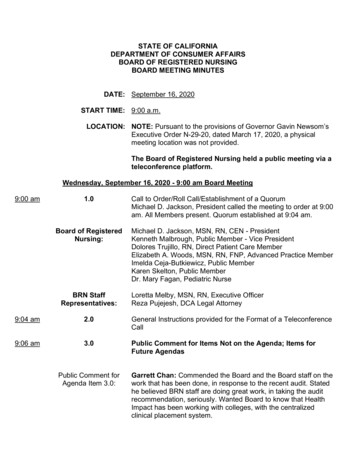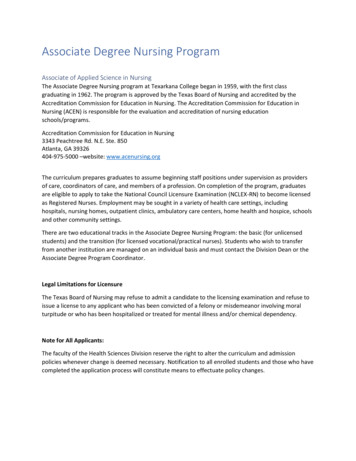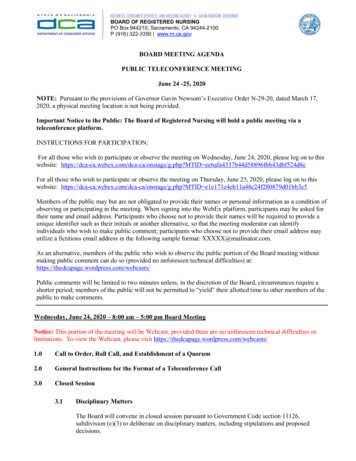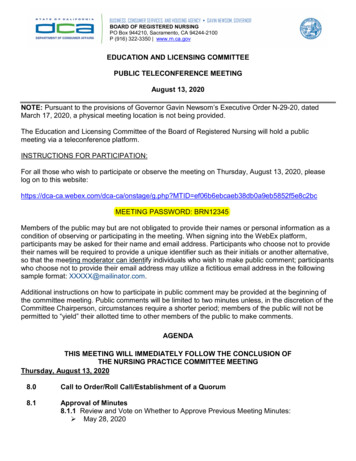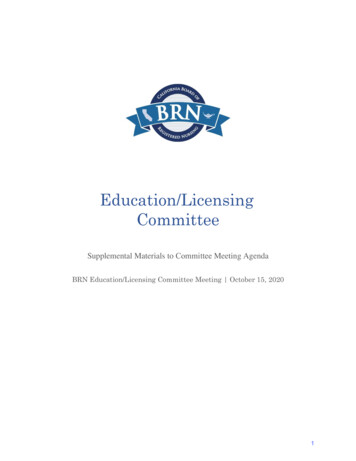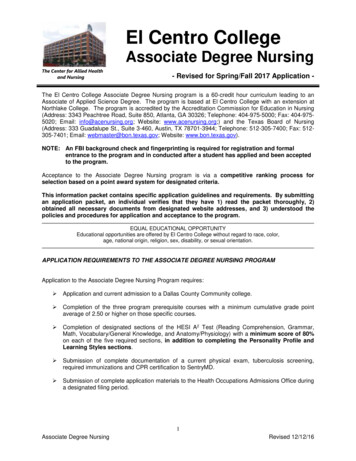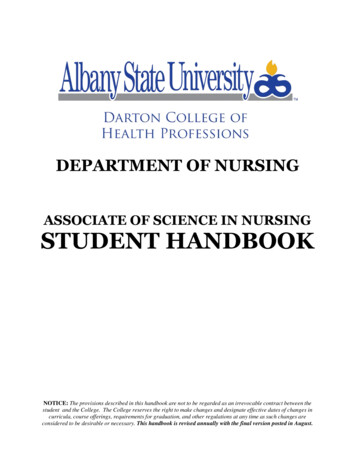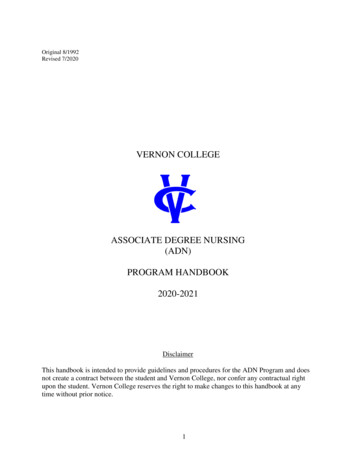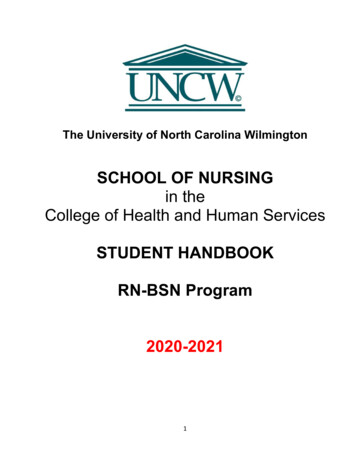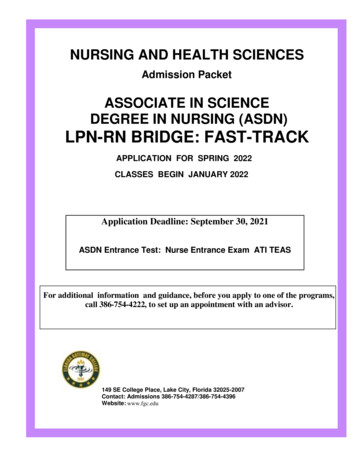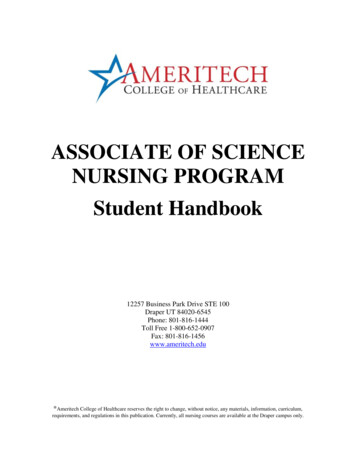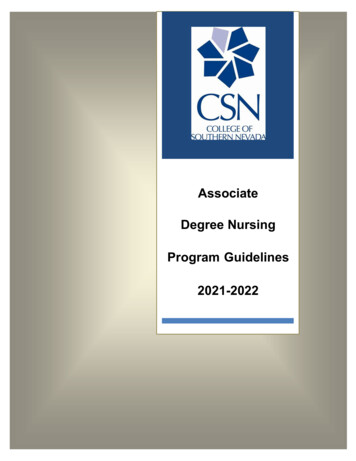
Transcription
AssociateDegree NursingProgram Guidelines2021-2022[Type text]Page 1
Table of ContentsAccreditation/Approval Status of the ADN Program .4Handbook Disclaimer .4Mission Statement .5Core Values .5General Information .6Curriculum – Regular Track Sequence .6Curriculum – Extended Track Sequence .7Curriculum – LPN to RN Bridge Track Sequence .8Philosophy .9Organizing Framework .11Organizing Framework Diagram .12Curricular Concept Definitions.13Associate Degree Nursing Student Learning Outcomes .16Associate Degree Nursing Program Outcomes .17Auditing a Course.18Course Registration and Disclaimer .18Professional Standards .19American Nurses Association Code of Ethics for Nurses .20NSNA Code of Academic and Clinical Conduct .21Honor Code . 22Academic Honesty Policy. 22Electronic Device Policy .23Students as Committee Members .24Types of Student Communication .24Communication Guidelines .24Mandatory Advising .26Missed Appointments.26Health Documents.27Name Change .27Academic Policies .28Progression in the Nursing Program .28To Remain in Good Academic Standing .28Track Change Requests .28Grades .29Credit Class Instructional Ratio .30Content Mastery Testing.30Learning Contract .30Unsatisfactory Progress Notification .31Associate Degree Nursing Program GuidelinesPage 2
Attendance and Preparedness .31Information on Absences from Exams, Lab, or Clinical Practicum .31Information on Tardiness to Exams, Lab, or Clinical Practicum.33Information on Being Unprepared .33Information on Referral to the Nursing Academic Progression and Graduation (APG)Committee .35Faculty Absences.36Course Withdrawal and/or Failure .36Reinstatement to a Nursing Program .37Program Return After Failure First Semester .37Transfer into the Nursing Program .38Medication Dosage Calculation Policy .38Clinical Policies.42Uniform and Dress Code .42Required Equipment .43Clinical Assignments . 43Confidentiality of Patient’s Records .44Nursing Documentation Guidelines .44Leveled Clinical Skills Notebook .44Intravenous Therapy .45Clinical Performance .46Clinical Evaluations .46Critical Incident .46Critical Elements .47Engelstad School of Health Sciences ADA Statement .47Tips for Success .48Student-to-Student Tips for Success .49Take Care of Yourself.49Take Care of Each Other.49Take One Day at a Time .49Take Care of Business .49Appendices.51Nursing Documentation Guidelines .52CSN Policy School of Health Sciences Student Reinstatement .54Student Learning Contract: Theory .57Student Learning Contract: Clinical/Lab .57Lab Tardy . 61Clinical Tardy .62Lab/Clinical Unpreparedness .63Lab/Clinical/Exam Absence .64Recommendation for Removal from a Health Sciences Program.65Name Change .66Associate Degree Nursing Program Graduate Reference .67Non-Discrimination Statement .70Revised 8/13/2015; Edited 7/18/2016; 6/20/2017; 7/11/2017; 7/20/2018; 7/10/2019; 7/9/2020, 8/3/2021Associate Degree Nursing Program GuidelinesPage 3
Accreditation/Approval Status of the Associate Degree NursingProgramCSN offers both an AAS degree in Nursing (for students who have not beenpractical/vocational nurses) and an AAS degree in Nursing LPN to RN BridgeEmphasis. Graduates are eligible to apply to write the NCLEX-RN exam for statelicensure. Courses from the AAS degree in Nursing can be applied toward therequirements for a Bachelor of Science in Nursing degree. The CSN programs havefull approval status by the Nevada State Board of Nursing, 4220 S Maryland Pkwy,Suite 300, Las Vegas, NV, 89119, (702) 486-5800 and are accredited by theAccreditation Commission for Education in Nursing, Inc., 3390 Peachtree Rd. N.E.,Suite 1400, Atlanta, GA 30326, (404) 975-5000.HANDBOOK DISCLAIMER:PLEASE NOTE THAT THE NURSING PROGRAM GUIDELINES FOR THECURRENT ACADEMIC YEAR WILL BE FOLLOWED. PAST EDITIONS OF THEGUIDELINES WILL NOT BE UTILIZED FOR ANY PURPOSES.AS A RESULT OF THE ONGOING CONCERNS OVER THE COVID-19 PANDEMIC,COURSE SYLLABI MAY BE ADJUSTED BY FACULTY AT ANY TIME DUE TOREQUIRED MANDATES FROM THE CSN, CLINICAL SITES, CDC, AND STATEAND FEDERAL GOVERNMENT ORGANIZATIONS.Associate Degree Nursing Program GuidelinesPage 4
Mission StatementThe CSN Nursing Department’s mission is to graduate competent, compassionate, caringnurses and nursing assistants who strive for excellence in their delivery of care to a diversecommunity. The department supports academic success through student engagement,cultural and scientific literacy, and assisting students to meet their educational andprofessional goals.Adopted Fall 2002: Revised Fall 2007; Fall 2009; Fall 2014; Spring 2017Core ValuesCaringActively create an environment of kindness and compassion that recognizes individualpreferences and needs in order to facilitate and support faculty and students inachievement of the nursing department mission.CommunicationActively create an environment that supports shared decision-making, cohesiveness,collaboration, and teamwork.CompetenceActively create an environment that strives for achievement of the outcomes of theAssociate Degree Nursing program and seeks to increase the level of achievementdefined in these outcomes.CreativityActively create an environment to foster evidence-based innovation in nursing education andpractice. Creativity is the highest level of knowledge described in the Revised Bloom'sTaxonomy.ProfessionalismActively create an environment that insists upon adherence to the standards of nursingeducation and practice including legal, ethical, and professional organization standards.Associate Degree Nursing Program GuidelinesPage 5
General InformationCurriculum – Full Time Sequence (Regular Track) (no nursing coursesduring summer sessions)Prerequisites ENG 101MATH 120 PSY 101BIOL 189BIOL 223Composition 1Fundamentals of College Mathematics(MATH 124 or above recommended)General PsychologyFundamentals of Life ScienceAnatomy & Physiology 13 cr.3 cr.3 cr.4 cr.4 cr.General Education Requirements BIOL 224BIOL 251SOC 101COM 101PSC 101Anatomy & Physiology 2 (prior to 2nd semester)Microbiology (prior to 3rd semester)Principles of Sociology (prior to 4th semester)Oral Communication (prior to 4th semester)Introduction to American Politics (by graduation)(or HIST 101 and 102 or HIST 101 and 217)4 cr.4 cr.3 cr.3 cr.4 cr.Introduction to Professional Nursing PracticePharmacology for Nursing Practice6 cr.2 cr.Medical-Surgical Nursing 1Mental Health Nursing6.5 cr.3 cr.Maternal-Newborn NursingPediatric Nursing3 cr.3 cr.Professional PracticeMedical-Surgical Nursing 2Medical-Surgical Nursing 33.5 cr.4.5 cr.2.5 cr.First Semester NURS 101NURS 125Second Semester NURS 115NURS 243Third Semester NURS 247NURS 248Fourth Semester NURS 208NURS 211NURS 296Total Associate of Applied Science – Nursing CreditsAssociate Degree Nursing Program Guidelines69 cr.Page 6
Curriculum – Part Time Sequence (Extended Track) (one nursing courseevery summer session)Prerequisites ENG 101MATH 120 PSY 101BIOL 189BIOL 223Composition 1Fundamentals of College Mathematics(MATH 124 or above recommended)General PsychologyFundamentals of Life ScienceAnatomy & Physiology 13 cr.3 cr.3 cr.4 cr.4 cr.General Education Requirements BIOL 224BIOL 251SOC 101COM 101PSC 101Anatomy & Physiology 2 (prior to 2nd semester)Microbiology (prior to 3rd semester)Principles of Sociology (prior to 4th semester)Oral Communication (prior to 4th semester)Introduction to American Politics (by graduation)(or HIST 101 and 102 or HIST 101 and 217)4 cr.4 cr.3 cr.3 cr.4 cr.Introduction to Professional Nursing PracticePharmacology for Nursing Practice6 cr.2 cr.Medical-Surgical Nursing 16.5 cr.Mental Health Nursing3 cr.Maternal-Newborn Nursing3 cr.Pediatric Nursing3 cr.Medical-Surgical Nursing 24.5 cr.Professional PracticeMedical-Surgical Nursing 33.5 cr.2.5 cr.First Semester NURS 101NURS 125Second Semester NURS 115Third Semester NURS 243Fourth Semester NURS 247Fifth Semester NURS 248Sixth Semester NURS 211Seventh Semester NURS 208NURS 296Total Associate of Applied Science – Nursing CreditsAssociate Degree Nursing Program Guidelines69 cr.Page 7
Curriculum – LPN to RN Bridge (Bridge Track) (no nursing courses duringsummer sessions)Prerequisites Graduation from an approved PN ProgramNV LPN licenseENG 101Composition 1MATH 120 Fundamentals of College Mathematics(MATH 124 or above recommended)BIOL 189Fundamentals of Life ScienceBIOL 223Anatomy & Physiology 1BIOL 224Anatomy & Physiology 2 (prior to 2nd semester)PSY 101General Psychology8 cr.3 cr.3 cr.4 cr.4 cr.4 cr.3 cr.General Education Requirements BIOL 251SOC 101COM 101PSC 101Microbiology (prior to 2nd semester)Principles of Sociology (prior to 3rd semester)Oral Communication (prior to 3rd semester)Introduction to American Politics (by graduation)(or HIST 101 and 102 or HIST 101 and 217)4 cr.3 cr.3 cr.4 cr.Additional Nursing Requirement NURS 125Pharmacology for Nursing Practice(prior to 3rd semester)2 cr.Introduction to Associate Degree NursingMental Health Nursing4.5 cr.3 cr.Maternal-Newborn NursingPediatric Nursing3 cr.3 cr.Professional PracticeMedical-Surgical Nursing 2Medical-Surgical Nursing 33.5 cr.4.5 cr.2.5 cr.First Semester NURS 205NURS 243Second Semester NURS 247NURS 248Third Semester NURS 208NURS 211NURS 296Total Associate of Applied Science – Nursing CreditsAssociate Degree Nursing Program Guidelines69 cr.Page 8
Associate Degree Nursing ProgramPhilosophyThe nursing faculty of the College of Southern Nevada (CSN) believes that the college strivesto meet the educational and health professional needs of the community by providing anAssociate Degree Nursing program whose graduates may matriculate into a partner RN-toBSN program. The nursing program provides student-centered instruction that emphasizesapplication of knowledge, development of critical thinking, caring, communication,professionalism, teaching/learning, and collaboration.The nursing faculty of CSN believes that individuals at all developmental stages are biological,psychological, social, cultural, and spiritual beings that interact with and adapt to their changinginternal and external environment. Each individual has unique capabilities, values, andexperiences that influence adaptive behaviors.Health is a dynamic process varying along a continuum from wellness, through illness, to death.The goal of adaptation is to achieve optimal health with maximum quality of life or death withdignity. Factors influencing health include inborn characteristics, developed capabilities, internaland external stressors, state of development, culture, social supports, spirituality, and anindividual’s perceived state of well-being. The individual, their family, and society share rightsand responsibilities for health.The American Nurses Association (2016) explain that “Nursing is the protection, promotion, andoptimization of health and abilities, prevention of illness and injury, facilitation of healing,alleviation of suffering through the diagnosis and treatment of human response, and advocacyin the care of individuals, families, groups, communities, and populations.” Nursing is a vitalcomponent of the interdisciplinary team. The nursing faculty of CSN believes that theuniqueness of nursing is in its humanistic, holistic, and collaborative approach to the healthcare of individuals throughout the lifespan.Graduates have learned to apply knowledge of the biological, behavioral, and social sciences,utilize critical thinking, and show caring as they provide safe and competent nursing care topatients of varied backgrounds. The graduates have demonstrated professional standards ofpractice, use of teaching/learning principles, and collaboration as they have practiced in avariety of healthcare settings in the community.Learning for professional practice is a lifelong endeavor. The nursing faculty of CSN believesthat learning is a dynamic process involving cognitive, affective, and psychomotor domains.Learning is an active constructive process during which the learner constructs knowledgethrough their experiences and reflections on those experiences. Learning is best achieved byactive participation in didactic and experiential situations. Learning is influenced by one’s valuesystem, past experience, motivations, perceptions, and learning style. Learners are responsibleand accountable for self-direction, personal and professional development, and utilization oflearning resources available from the college and the community. The nursing faculty of CSNbelieves that a positive, caring, supportive, and respectful student-teacher relationship isessential to promote a spirit of inquiry as well as professional and personal development. NurseAssociate Degree Nursing Program GuidelinesPage 9
educators have the responsibility to assist students in development of moral, legal, and ethicalconscience that will enable them to meet the challenges found in the changing health careneeds of society.The population of the community includes socio-culturally diverse individuals with varyingeducational and personal goals. The College of Southern Nevada actively encourages theinclusion of faculty and students from various backgrounds. Additionally, the faculty believes wecan influence the lives of students and the community as we prepare professional nursinggraduates. We are committed to the integrity of our program and the competence of ourgraduates.Approved 4/16/2004Reviewed 10/2009Revised 3/2017Approved 5/2017Reviewed 2/2018Associate Degree Nursing Program GuidelinesPage 10
Organizing FrameworkUsing the philosophy as a foundation, the CSN faculty of nursing developed an organizingframework for the Associate of Applied Science-Nursing curriculum. The organizing frameworkuses the key curricular concepts of application of knowledge, development of critical thinking,caring, communication, professionalism, teaching/learning, and collaboration. The key curricularconcepts include the behaviors of practicing within a regulatory framework, ethical standards,valuing a nursing career, and commitment to professional growth, continuous learning, and selfdevelopment.The concept of adaptation focuses on each individual as being unique and viewed as biological,psychological, social, cultural, and spiritual beings that interact with and adapt to their changinginternal and external environment. Each individual has unique capabilities, values, andexperiences that influence adaptive behaviors. Adaptation is a dynamic process because theindividual’s environment is continually changing. Each person has unique characteristics,capabilities, physical emotional, social, and spiritual needs, value systems, and live experiencesthat influence adaptive behaviors. An individual’s response to environmental change results inadaptive or maladaptive responses. Adaptive responses are coping mechanisms that promotehealth, growth, and quality of life or death with dignity. A goal of nursing is to promoteadaptation. Encouraging adaptation assists individuals and their families to maintain or achievehealth, growth, and quality of life or death with dignity.The CSN AAS nursing graduate interacts with patients using the concepts of application ofknowledge, critical thinking, caring, communication, professionalism, teaching/learning, andcollaboration to assist patients to adapt to their changing internal and external environments withthe goal of promoting health, growth, and quality of life or death with dignity. This is illustrated inthe Organizing Framework Diagram on the next page.ReferencesAmerican Nurses Association. (2016).What is Nursing? Retrieved hat-Is-NursingApproved 4/16/2004Re-approved 10/2009Revised 3/2017Approved 5/2017Reviewed 2/2018Associate Degree Nursing Program GuidelinesPage 11
Organizing Framework DiagramRevised 3/2017Approved 5/2017Reviewed 2/2018Associate Degree Nursing Program GuidelinesPage 12
Curricular Concept DefinitionsAdaptationAdaptation is a dynamic process in which an individual/family responds to change in theirenvironment. Adaptive coping leads to optimal health, quality of life, or death with dignity.Individual/FamilyAn individual is a physiological, psychological, socio/cultural, and spiritual being with uniqueinherent characteristics, capabilities, value systems, and life experiences. A family is a groupof individuals who provide mutual support and nurturance. The individuals in a family may beliving together, be related by blood or be related by marriage. Individuals and families have theright to optimal health, quality of life, or death with dignity.EnvironmentThe environment consists of the physical, socio/cultural, political, and spiritual influences,circumstances, and conditions that surround and affect the health of individuals and groups.Optimal HealthOptimal health is maximum wellbeing that arises from the ability to function physically,psychologically, socio/culturally, and spiritually at one’s highest level.Quality of LifeQuality of life is a complex concept that includes the effect of an individual’s health on thatperson’s ability to find meaning and achieve purpose in life.Death with DignityA dignified death is defined as the process of dying during which the preferences of the personand family is respected, comfort is promoted, and the grieving process is facilitated so that themaximum quality of life of the person and their family is fostered.Application of KnowledgeApplication of knowledge is defined as the utilization of information from the basic sciencesand nursing, and the nursing process while critical thinking in clinical situations to providenursing care.Nursing ProcessThe nursing process is a systematic method for providing nursing care. The nursing processincludes assessment of the patient’s health status, identification of health care problems,Associate Degree Nursing Program GuidelinesPage 13
establishment of patient-centered goals, planning of nursing interventions to achieve theestablished goals, implementation of the nursing interventions, and evaluation of achievementof the established patient-centered goals.Critical ThinkingCritical thinking is used in every step of the nursing process and is essential to providingoptimal, individualized, patient-centered nursing care. The two dimensions of critical thinkingare critical thinking dispositions and critical thinking skills. Critical thinking dispositions arequalities of individuals that promote solving problems using critical thinking skills, rather thanother methods of problem-solving, and include: truth-seeking, open-mindedness, analyticity,systematically, inquisitiveness, maturity, and trust in reasoning skills. Critical thinking skills aremental processes of individuals used to solve problems and include: interpretation, analysis,evaluation, inference, explanation, and self-regulation (Facione, 1990).Facione, P. (1990). Critical thinking: A statement of expert consensus for purposes of educational assessment and instruction.The Delphi report: Research findings and recommendations prepared for the American Philosophical Association: Executivesummary. Fullerton, California: California Academic Press. Retrieved i Report.pdfCaringCaring is knowledgeable and deliberate, rather than an emotional response. While caring, thenurse demonstrates concern for the inner life and subjective meaning of the patient. Caringembraces and intersects with art, science, humanities, and spirituality. Caring occurs within atranspersonal relationship between the nurse and patient (Watson Caring Science Institute,n.d.) in a climate of hope and trust where patients’ preferences are respected. Through caring,the patient is supported and empowered to adapt and achieve optimal quality of life or deathwith dignity.Watson Caring Science Institute. (n.d.). Caring science theory, research and measurement. Retrieved ent of CareManagement of care is providing and directing nursing care that enhances the care deliverysetting to protect patients and health care team members. Management of care is an integralpart of fostering patient adaption and achievement of optimal quality of life or death withdignity. Management of care is a complex concept that involves many factors including but notlimited to advocacy, patient rights, collaboration, management, confidentiality, delegation,supervision, ethical practice, and quality improvement. Management of care is performedwithin a safe and effective care environment and the legal, ethical and regulatory frameworksof the nursing profession (National Council of State Boards of Nursing, 2016).National Council of State Boards of Nursing. (2016). 2016 NCLEX-RN Detailed Test Plan. Retrieved fromhttps://www.ncsbn.org/2016 RN DetTestPlan Educator.pdfAssociate Degree Nursing Program GuidelinesPage 14
CommunicationCommunication is an interactive process through which there is an exchange of information.Communication may be written, occur verbally or nonverbally, and may be facilitated bytechnology. Communication is essential to all steps of the nursing process. Therapeuticcommunication occurs in a trusting relationship between the nurse and patient and focusesexclusively on the needs and concerns of the patient.ProfessionalismProfessionalism is demonstrated by the behavior of a member of a profession. Nursingprofessional behavior includes commitment to the nursing profession, adherence to standardsof professional nursing practice, and practice within the legal, ethical and regulatoryframeworks of the nursing profession.Teaching-LearningTeaching is the process of facilitating learning. Learning is the process whereby knowledge orskills are acquired. Effective teaching methods are based upon theories of learning andprinciples of teaching. When providing nursing care, teaching is used to promote the patient’sadaption and achievement of optimal quality of life or death with dignity.CollaborationCollaboration involves communication with patients, their families, and other healthcareprofessionals. Collaboration among these entities includes shared planning, decision-making,problem solving, and goal setting. The result of collaboration is efficient utilization ofresources, skills, and talents to foster patient adaption and achievement of optimal quality oflife or death with dignity.Approved 4/16/2004Re-approved 10/2009Revised 7/2016; 3/2017Approved 5/2017Reviewed 2/2018Associate Degree Nursing Program GuidelinesPage 15
Associate Degree Nursing Student Learning OutcomesUpon graduation from the CSN Associate Degree Nursing Program, the graduate will be ableto:1. Incorporate physiological, psychological, social-cultural, and spiritual concepts to providesafe and competent nursing care for patients at various stages in their life.2. Combine the nursing process with clinical reasoning to assist patients with adaptivebehaviors that enhance, maintain, and promote optimal health, quality of life, and/or deathwith dignity.3. Demonstrate caring behaviors with patients to attain optimal health, quality life, or deathwith dignity.4. Apply principles of verbal and written communication with professionals and patients.5. Provide patient care employing the Qual
MATH 120 Fundamentals of College Mathematics 3 cr. (MATH 124 or above recommended) PSY 101 General Psychology 3 cr. BIOL 189 Fundamentals of Life Science 4 cr. BIOL 223 Anatomy & Physiology 1 4 cr. General Education Requirements BIOL 224 Anatomy & Physiology 2 (prior to 2. nd
